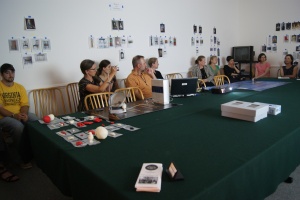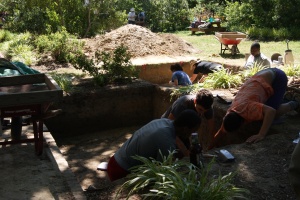I spent the day in Williamsburg today with Dr. Means and fellow VCU students Courtney Bowles and Alan Huber. They were there to give a demonstration of the 3D scanning equipment to the Colonial Williamsburg Foundation, and were kind enough to let me tag along as I will be joining them as an intern this fall! The Virtual Curation Unit, part of the Department of Defense’s Legacy Program, is a project at VCU that is lead by Dr. Means. The goal of the project is to use a 3D scanner and software to create 3-dimensional digital copies of artifacts from various archaeological sites and test the equipment’s capabilities and limitations. These copies can be used to study, analyze, and conserve artifacts without having to handle them too much. Having them also creates the opportunity to share these artifacts with the public through digital means. We also have a 3D printer, which generates plastic replicas of artifacts based on the scans. This was my first time being involved in the project or handling the equipment so I was a bit nervous, but excited!
We arrived early, so instead of getting straight to work we dropped off the equipment and took a walk around Colonial Williamsburg. On our way we stopped at two archaeological sites, the blacksmith shop and armory and a field school site on the College of William and Mary’s campus. When we arrived at the William and Mary site we were warmly greeted by field director Mark Kostro, who explained the project to us. The site was once the location of the Bray School, a religious school for free and enslaved African-Americans during the 18th Century. It was supposedly held in a cottage that once stood where the Brown Hall dormitory now stands. The excavation site is located directly beside the dorms, which would have been the Bray School’s yard, and they are hoping to find material evidence that confirms that the school did, in fact, exist here.
They began excavation of this site with geosurvey and then dug some shovel test pits to establish where to dig their units. There were some anomalies in the results, so they based the location of their units on them. They already had a few very large areas opened up when we arrived, and I was impressed by their depth and the clear stratigraphy displayed in each profile, as it was much more defined than anything I’ve seen at Ferry Farm! It was really interesting for me to see another site and to learn about the methods used there, especially since they are so drastically different than the ones I have been using!
After our adventure in town we returned to the Archaeology Lab to get ready for the demonstration. Courtney showed me how to set up the scanner while Allen set out all of the plastic artifact replicas and information. Emily Williams, Conservator of Archaeological Materials at The Colonial Williamsburg Foundation, was very warm and welcoming and brought us some samples to scan. One item was a pair of small 19th Century leather shoes, which everyone was very eager to try! Dr. Means quickly taught me how the software works and how to start a scan, and before I knew it we were creating a 3D image of a shoe! It worked a lot more quickly than I thought it would, and by the time it was done there was a room full of people who had gathered to see how the machine works. They seemed to be very impressed and had plenty of questions about the project. As Dr. Means explained the purpose of the project and mechanics of the scanner, others began bringing in artifacts to test.

The next one was a Chinese export porcelain bowl that dates to the 18th century. The team was worried that it wouldn’t work because of the shiny glaze, but after the first few rotations we could see that it was not only gathering the shape of the bowl, but the bright colors and beautiful design as well. By the time it was done, we had a great image that was so clear the brush strokes in the paint could be seen on the sides! We tried a couple of metal objects after that, but the surfaces were too reflective for the scanner to record. Dr. Means said that if they were coated in powder they might work, and that he would be happy to try it next time he comes down! After all of the questions were answered and the scans complete, we packed up and headed out.
It was so exciting to be a part of the demonstration, and I am very happy that I got to go and learn more about the project and the equipment! I will be getting some more in-depth training on Friday, when I join Dr. Means for some scanning at Ferry Farm! I will also be blogging from the field that day, as Friday is the Day of Archaeology, when archaeologists around the world will be sharing what they do to raise awareness about this amazing field!
You can read more about the Day of Archaeology on their website (http://www.dayofarchaeology.com/), and be sure to tune in on Friday to see what everyone is up to!!!
Also, please check out the Virtual Curation Unit blog (http://vcuarchaeology3d.wordpress.com/) to see some 3D scans, learn more about the project, and read all about the team’s adventures!
